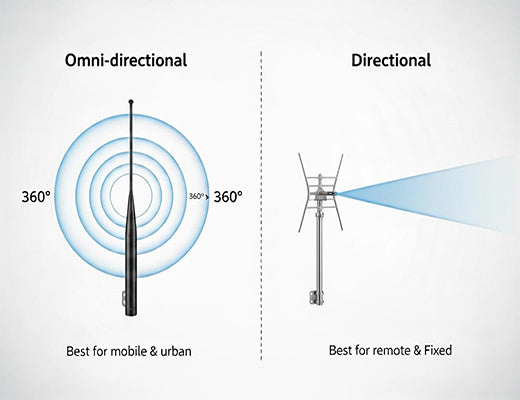
A Guide to Choosing the Right Antennas for Your Cellular Router
|
|
Time to read 5 min
|
|
Time to read 5 min
Choosing the right antennas for your cellular router is just as important as choosing the router itself. The best router in the world is useless without a good signal. This practical guide will walk you through the key concepts you need to understand—from omni-directional vs. directional antennas and the meaning of "gain" (dBi), to best practices for antenna placement—to ensure you get the strongest, most reliable connection possible for your deployment.
Antennas are not a one-size-fits-all accessory; the right choice depends on your specific location and application.
The three most important factors to consider are antenna type (omni-directional vs. directional), gain (measured in dBi), and, most importantly, proper placement.
For routers with multiple antenna ports (MIMO), it is critical to use multiple, properly spaced antennas to achieve the best possible speed and reliability.
Using high-quality, low-loss cables is essential for outdoor or remote antenna installations to avoid signal degradation.
I've seen so many projects where a company invests in a top-of-the-line industrial cellular router, only to get frustratingly slow and unreliable performance. They blame the router, they blame the cellular carrier... but nine times out of ten, the real culprit is sitting right on top of the device: the antennas.
Let's be clear: your antennas are the ears and mouth of your router. They are the physical connection to the cellular network. Choosing the wrong ones, or installing them poorly, is like trying to have a conversation in a loud room with your hands over your ears.
The good news is that understanding the basics of choosing the right antennas for your cellular router is straightforward. This guide will give you the practical knowledge you need to ensure your installation is a success.

This is the most common type of antenna, often called a "whip" or "paddle" antenna.
These antennas (like Yagi or Panel antennas) are designed to be aimed.
You'll see antenna performance measured in "dBi." This is its "gain." The real 'aha!' moment for many is understanding that gain isn't like turning up the volume on a speaker. An antenna doesn't create a more powerful signal.
Gain is a measure of an antenna's ability to focus the signal. A higher gain (e.g., 10 dBi) on a directional antenna means it has a more tightly focused beam, allowing it to reach farther. A higher gain on an omni-directional antenna means its 360-degree pattern is flattened into a thinner disk, giving it more horizontal reach at the expense of vertical reach.
Warning: More gain is not always better! A very high-gain omni antenna in a location with lots of signal reflections can actually perform worse than a lower-gain one.
I cannot stress this enough: where you put your antennas is the single most important factor for a successful installation.

Choosing the right antennas for your cellular router isn't an afterthought; it's an integral part of designing a reliable communication system. By understanding the basics of antenna types, gain, and proper placement, you can ensure that your industrial router has the clean, strong signal it needs to deliver the mission-critical connectivity your application demands.
Learn More in our main guide:

A1: You should never do this. Routers with multiple cellular ports use MIMO technology, which relies on multiple antennas to achieve its high speeds and reliability. Using only one antenna will severely degrade your performance and connection stability.
A2: A combination or "combo" antenna is a single, rugged housing that contains multiple antennas inside. For example, a "5-in-1" vehicle antenna might have four cellular antennas (for 4x4 MIMO) and one GPS/GNSS antenna all in one low-profile, roof-mounted unit. They are extremely convenient for mobile and outdoor installations.
A3: There are several great third-party websites and mobile apps (like CellMapper or OpenSignal) that can provide maps of cell tower locations based on crowd-sourced data. This is an essential tool if you plan on using a directional antenna.